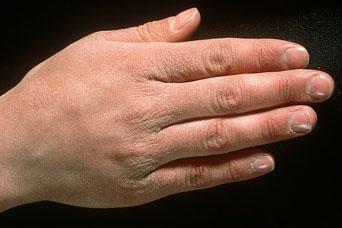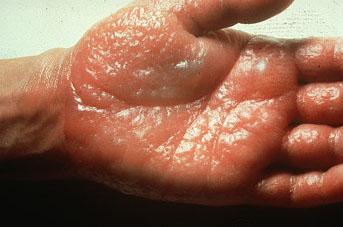ECZEMAS AND DRUG HYPERSENSITIVITY
3.4
Symptoms and manifestations of contact dermatitis and eczema
In early stages, irritant contact dermatitis manifests itself in itch, redness, fine scales, and cracks. Signs of allergic contact dermatitis include itch, redness, swelling, small blisters, and oozing. Chronic exposure or uncontrolled ongoing inflammation leads to itchy red, thickened skin with scales and fissures in both types. A distinction between irritant and allergic contact dermatitis is often not possible simply based on the appearance of the eczema.
The most commonly affected body parts in contact dermatitis are the hands, face, neck, and lower legs – since these locations are more often exposed to irritants or contact allergens. The eczema is localised at the site of exposure with some spreading to close skin areas. Rarely disseminating eczema may affect larger surfaces of the skin and the whole skin may become inflamed, a condition called erythroderma – ancient Greek for ‘red skin’. From a clinical point of view, a distinction based on the appearance of the eczema is often not possible. Age at onset, localization, and distribution are some features which may allow to differentiate between the two.
The clinical manifestation of eczema varies depending on their stage. Acute eczemas occur with erythema, papules and vesicles, oozing, and erosions. Whereas chronic eczemas also show erythema but thickened, so-called lichenoid skin and large scales. This may lead to painful cracks and fissures close to the small joints.
Irritant contact dermatitis

- Mechanism: Disturbed skin barrier surface
- Onset: Repeated weak stimulus over time
- Manifestation: Burning/itch, mild redness, and fine scales or cracks; later erosions, crusts, cracks, and skin thickening (in chronic stages)
- Causes: Frequent washing, heavy soap use, contact with solvents, or low temperatures
Allergic contact dermatitis

- Mechanism: T cell mediated allergic inflammation
- Onset: 1-2 days after contact
- Manifestation: Strong itch, redness, swelling, blisters, and oozing; later erosions, crusts, cracks, and skin thickening (in chronic stages)
- Causes: Contact allergens
License
University of Basel
